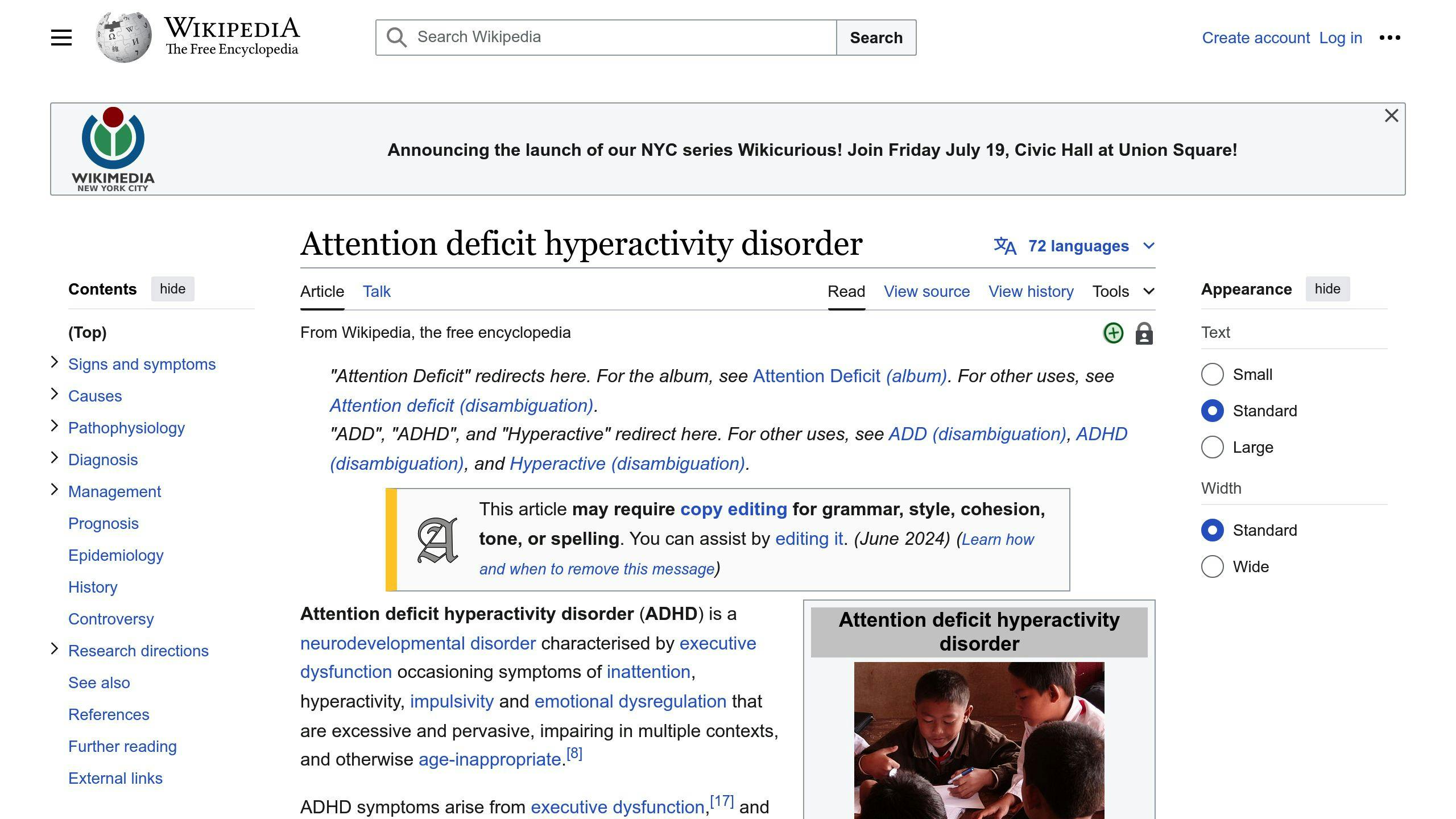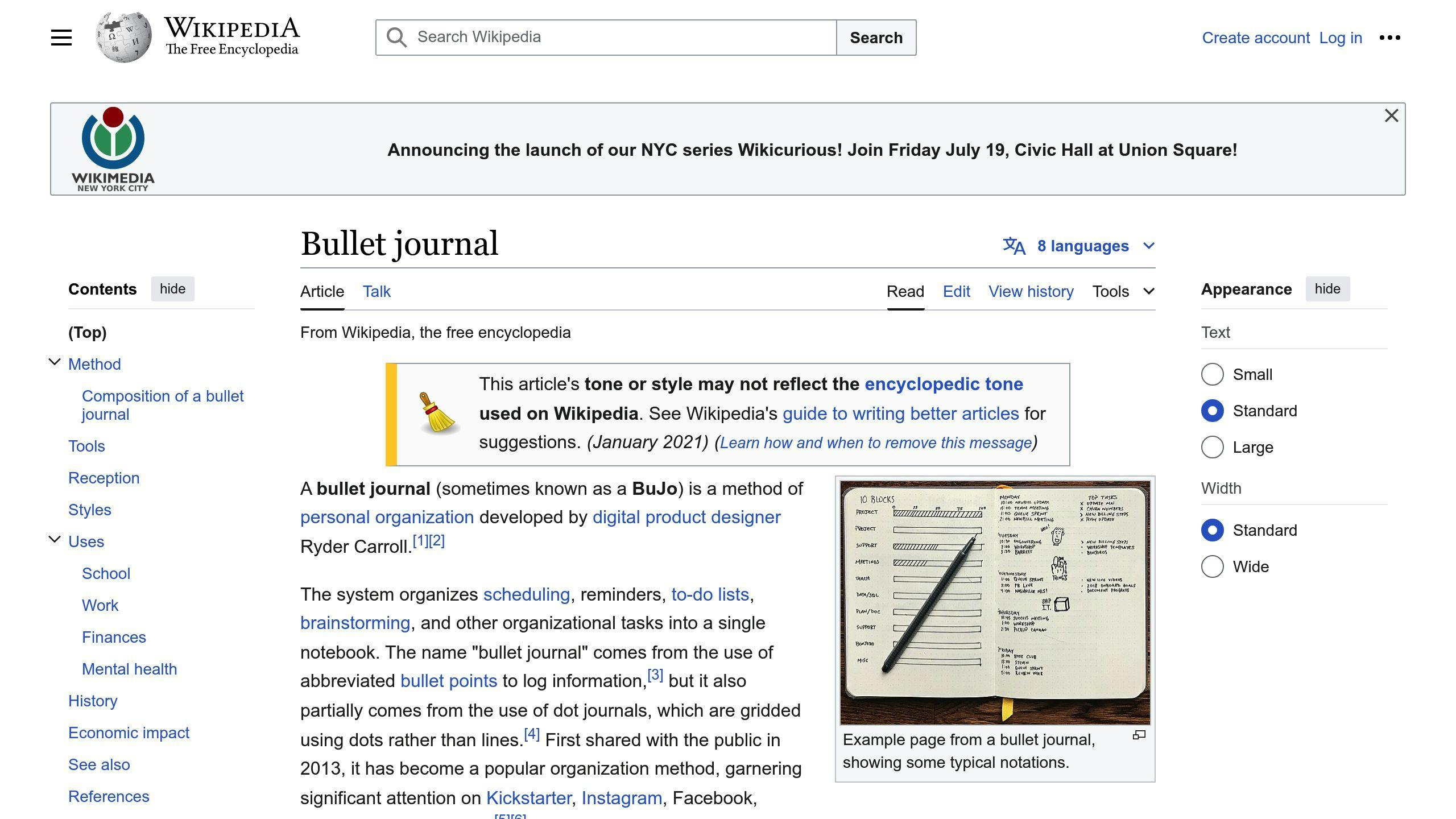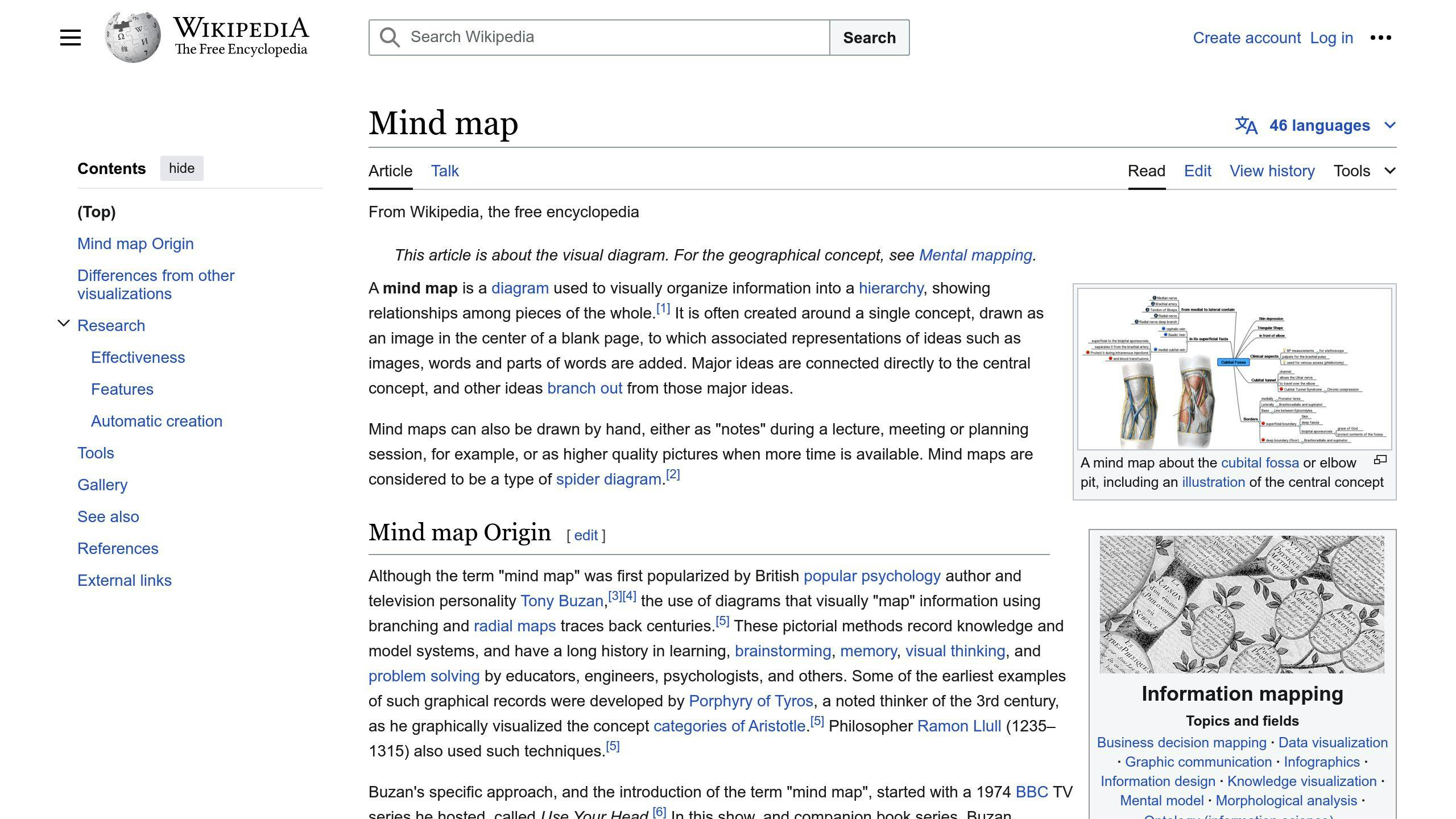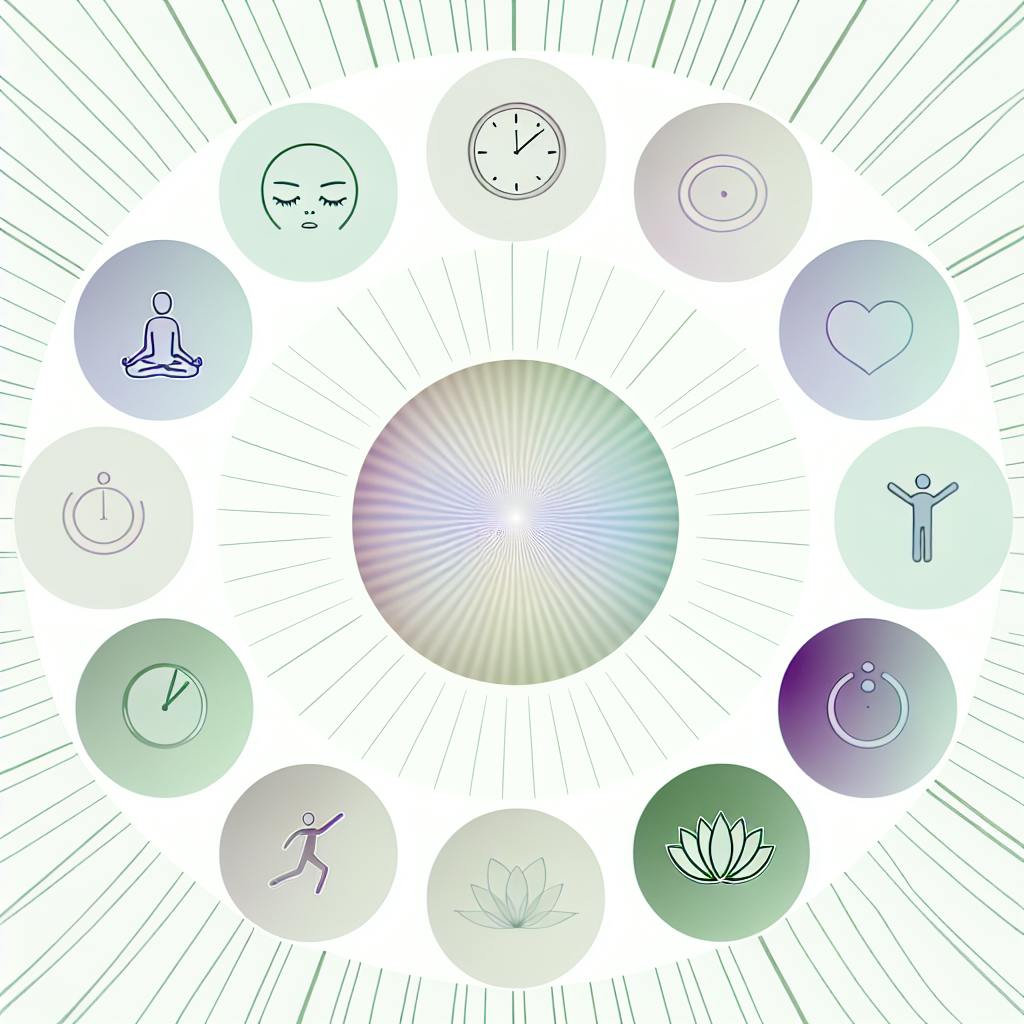Journaling can help manage ADHD symptoms by:
• Clearing your mind • Improving focus and organization • Managing emotions • Reducing stress • Tracking goals and progress
Key journaling methods for ADHD:
- Bullet journaling
- Mind mapping
- Free writing
- Using prompts
- Visual/drawing journaling
Tips to start:
- Choose paper or digital format
- Set small, achievable goals
- Make it a daily habit
- Use prompts when stuck
Helpful prompts:
| Category | Example |
|---|---|
| Daily reflection | What did you do well today? |
| Goal-setting | List your top 3 tasks for tomorrow |
| Emotion check | Describe your feelings using colors |
| Problem-solving | List 5 possible solutions to a current issue |
Customize your journal with layouts, habit trackers, and visual aids. Combine journaling with other ADHD strategies like mindfulness and medication tracking for best results.
Related video from YouTube
ADHD and Journaling Basics

What is ADHD?
ADHD (Attention Deficit Hyperactivity Disorder) is a brain condition that affects kids and adults. It has three main symptoms:
| Symptom | Description |
|---|---|
| Inattention | Hard to focus, notice details, or finish tasks |
| Hyperactivity | High energy, restlessness, talking a lot |
| Impulsivity | Acting without thinking, interrupting, can't wait |
These symptoms can make daily life hard in work, relationships, and staying organized.
How Journaling Helps with ADHD Symptoms
Journaling can help manage ADHD symptoms:
| ADHD Symptom | Journaling Benefit |
|---|---|
| Inattention | Organizes thoughts and tasks |
| Hyperactivity | Provides a calm activity |
| Impulsivity | Allows time to think before acting |
Journaling helps people with ADHD:
- List and rank tasks
- Clear their mind
- Create daily routines
- Break big tasks into small steps
- See their progress over time
Journaling and Brain Function
Studies show journaling can help brain function, which is good for people with ADHD:
- Better memory: Writing things down helps remember them
- More focus: Writing uses many senses, which can help concentration
- Less stress: Writing about feelings can lower stress
- Control emotions: Journaling helps understand and manage feelings
- Solve problems: Free writing can lead to new ideas
How Journaling Helps People with ADHD
Journaling can greatly help people with ADHD in their daily lives. Here's how:
Better Focus and Clear Thinking
Writing in a journal helps people with ADHD:
- Sort out their thoughts
- Choose what's most important to do
- Have less mental clutter
This makes it easier to focus on important tasks.
Better Time Management and Organization
Journaling helps with time management and staying organized:
| Benefit | How It Helps |
|---|---|
| Choosing what to do first | See which tasks are most important |
| Planning | Use as a daily, weekly, or monthly planner |
| Breaking big tasks into small ones | Make large tasks easier to handle |
| Tracking progress | See what's done and how you've grown |
Using a journal regularly can improve time management and organization skills.
Managing Emotions and Understanding Yourself
ADHD often comes with strong feelings. Journaling helps by:
- Letting you write about your feelings
- Helping you understand your behavior and what triggers emotions
- Giving you a way to handle intense feelings
This can lead to better choices and relationships.
Less Stress and Worry
ADHD can be stressful, but journaling can help:
- It's a place to write about worries
- It helps find what causes stress
- It lets you focus on good things
- It's a way to be kind to yourself
Writing about stress regularly can help you feel more in control and less worried.
Getting More Done and Reaching Goals
Journaling is great for setting and reaching goals:
| How It Helps | What You Can Do |
|---|---|
| Make goals clear | Write down what you want to achieve |
| Plan steps | Break big goals into smaller tasks |
| See progress | Keep track of what you've done |
| Stay on track | Use your journal to remind yourself of your goals |
Starting Your ADHD Journal
Here's how to begin journaling to help manage ADHD:
Picking a Journal: Paper or Digital
Choose between paper and digital journals based on what works best for you:
| Format | Good Points | Not So Good Points |
|---|---|---|
| Paper Journal | - You can touch and feel it - No pop-ups to distract you - Helps you remember better |
- Easy to lose - Limited space - Can't search through it |
| Digital Journal | - Always with you on your phone or computer - Easy to search and sort - Can set alarms |
- Might distract you - Needs power to work - Might feel less personal |
Pick the one that fits your needs best. Some people use both, depending on the situation.
Setting Doable Goals
Start small to build good habits:
1. Write for a short time: Try 5-10 minutes of journaling each day.
2. Focus on good entries, not long ones: Write things that matter to you.
3. Set easy targets: Start with 3-5 sentences or bullet points per entry.
Remember, journaling should help you, not stress you out.
Making Journaling a Routine
Add journaling to your daily life:
- Pick a set time: Write at the same time each day, like after waking up or before bed.
- Link it to something you already do: Journal while having your morning coffee.
- Keep it close: Put your journal where you can see and reach it easily.
- Use reminders: Set alarms to remind you to write.
Keep at it, and it will become a habit over time.
Dealing with Common Problems
Here's how to handle typical ADHD journaling issues:
| Problem | Solution |
|---|---|
| Don't know what to write | Use prompts or pre-written questions to get started |
| Skipping days | Don't worry, just start again without feeling bad |
| Trying to make it perfect | Remember, it's just for you. It's okay if it's not perfect |
| Getting distracted | Find a quiet place to write. Turn off your phone or use apps that block notifications |
Useful Journaling Methods for ADHD
Here are some good ways to journal if you have ADHD:
Bullet Journaling

Bullet journaling helps organize thoughts and tasks. It's good for ADHD because you can change it to fit your needs.
How to use bullet journaling:
- Write short notes and lists
- Group information by topic
- Plan for the future
- Break down tasks by day and month
| Good Points | Not So Good Points |
|---|---|
| Can change it how you like | Might seem hard at first |
| Keeps many tools in one place | Need to keep doing it |
| Helps you look back and plan ahead | Might not work if you prefer digital tools |
Mind Mapping

Mind mapping helps you draw out your ideas. It's good for ADHD because it lets you see how your thoughts connect.
How mind mapping helps:
- Lets you think in new ways
- Makes big projects easier to handle
- Shows how ideas fit together
To make a mind map:
- Put your main idea in the middle of the page
- Draw lines to other ideas that connect
- Use colors or pictures to make it easier to remember
Free Writing
Free writing means writing without stopping to fix mistakes. This can help people with ADHD:
- Clear their mind
- Start writing when it's hard
- Think of new ideas
Tips for free writing:
- Set a timer for 10-15 minutes
- Keep writing, even if you repeat words
- Don't worry about spelling or grammar
- Focus on writing, not on making it perfect
Using Prompts and Guided Entries
Prompts are questions or ideas to help you start writing. They can:
- Give you ideas to write about
- Help you think about yourself
- Make it easier to write often
Some good prompts for ADHD:
- What three things do I want to do today?
- How did I use my time well this week?
- What made my ADHD act up recently?
Drawing and Visual Journaling
Adding pictures to your journal can make it more fun if you have ADHD.
Ways to add pictures:
- Draw small pictures for your ideas or feelings
- Use different colors for different types of notes
- Use stickers to mark important things
How pictures help:
- Show thoughts that are hard to write
- Help you remember what you wrote
- Make journaling more fun
sbb-itb-9e0c8ab
Journaling Prompts for ADHD
Journaling prompts for ADHD can help you write about your thoughts and feelings. They make it easier to start writing and stay focused. Here are some good prompts for different parts of managing ADHD:
Daily Reflection Questions
| Question | Purpose |
|---|---|
| What did you do well today? | Recognize achievements |
| How did you manage your time? | Identify good habits |
| What distracted you? How did you deal with it? | Understand challenges |
| When did you feel most focused? Why? | Find what helps you concentrate |
| What did you learn about yourself? | Gain self-awareness |
Goal-Setting and Task Planning
| Prompt | Benefit |
|---|---|
| List your top 3 tasks for tomorrow | Plan ahead |
| Pick a big goal. What small steps can you take? | Break down large tasks |
| Which task are you avoiding? What's the smallest step? | Overcome procrastination |
| How can you make a hard task more fun? | Increase motivation |
| Think about a recent win. What helped you succeed? | Learn from successes |
Understanding Your Emotions
- Describe your feelings using colors or weather
- What made you feel strong emotions today?
- When did you feel calm? Why?
- How does ADHD affect your emotions?
- Write a letter to your feelings
Problem-Solving Ideas
| Challenge | Prompt |
|---|---|
| Current issue | List 5 possible solutions |
| ADHD-related problem | If you could fix one thing, what would it be? |
| Recent setback | What good came from it? |
| Distractions | What's one new way to manage them? |
Positive Thinking
- List 3 good things about your ADHD
- What personal strength helps with your ADHD?
- When was ADHD helpful recently?
- Who supports you with ADHD? How do they help?
- What positive change have you noticed in yourself?
Try to use one prompt each day in your journal. This can help you understand yourself better and manage ADHD more easily.
Customizing Your Journal for ADHD
Making your journal work for you is key to managing ADHD. Here's how to set it up:
Creating Your Own Layouts
Keep it simple when designing your journal:
- Use clear symbols and colors
- Make pages for daily tasks, events, and goals
- Try different layouts to see what works
- Focus on what helps, not how it looks
Adding Habit Trackers
Habit trackers help you see your progress. Track things like:
- Daily routines
- Taking medicine
- Sleep
- Exercise
- Water drinking
Use simple charts or colors to make tracking easy.
Using Colors and Visual Aids
Pictures and colors can make your journal more fun:
- Use different colors for different tasks
- Draw stars next to important things
- Use tape or stickers to mark pages
- Make mind maps for new ideas
The goal is to make your journal easy to use and look at.
Combining with Task Management Tools
Your journal can work with other ADHD tools:
- Phone reminders for tasks
- Blocking out time for work
- Using timers for focus
- Looking back each week to see how you did
Using your journal with these tools helps you manage ADHD and get more done.
| Journal Feature | How It Helps ADHD |
|---|---|
| Simple layouts | Makes things less confusing |
| Color coding | Helps organize visually |
| Habit trackers | Helps you stick to goals |
| Pictures and colors | Makes the journal more fun to use |
| Works with other tools | Helps you get more done overall |
Advanced Journaling for ADHD
Here are some more ways to use journaling to help with ADHD:
Journaling with Other ADHD Strategies
Use your journal with other ADHD tools:
1. Mindfulness and Journaling
- Write about how mindfulness exercises affect your focus and feelings
- Try to focus only on writing when you journal
2. Medication Management
- Keep track of when you take medicine and how it works
- Write down any side effects to tell your doctor
3. Therapy Integration
- Write down what you want to talk about in therapy
- Note what you learn in therapy and how you're doing
Long-Term Goal Planning
Use your journal to set and reach big goals:
| Goal Step | Journal Method |
|---|---|
| Pick Goals | Write freely |
| Picture Success | Draw or paste pictures |
| Break Down Steps | Make a mind map |
| Check Progress | Use habit trackers |
Journaling for Work and School Success
Use your journal to do better at work or school:
1. Project Planning
- Use mind maps to plan projects
- Make timelines for big projects
2. Meeting Notes
- Have a special part of your journal for meeting notes
- Use colors or symbols to mark important things
3. Study Help
- Write down what helps you study best
- Try studying in short bursts and use your journal to take breaks
Overcoming ADHD Journaling Hurdles
Journaling for ADHD can be hard. Here are some ways to make it easier:
Keeping a Regular Journaling Habit
To journal often:
| Tip | How to Do It |
|---|---|
| Start small | Write for 5-10 minutes a day |
| Make it a habit | Journal at the same time each day |
| Use reminders | Set alarms on your phone |
| Keep it close | Have your journal where you can see it |
Avoiding Perfectionism and Overwhelm
Don't worry about making your journal perfect:
- It's just for you: Don't stress about spelling or neatness
- Use prompts: When stuck, use questions to help you write
- Write less: Try short notes or bullet points
- Try new things: Use lists, drawings, or mind maps
Staying Motivated
To keep writing:
| Method | Description |
|---|---|
| Look back | Read old entries to see how you've grown |
| Reward yourself | Give yourself a treat for writing often |
| Join others | Talk to people who also journal |
| Change it up | Try new ways to journal when bored |
Conclusion
Journaling helps people with ADHD in many ways. It can make daily life better by:
| How Journaling Helps | What It Does |
|---|---|
| Clears the mind | Helps focus on important things |
| Keeps track of tasks | Makes it easier to remember what to do |
| Helps with feelings | Gives a place to write about emotions |
| Lowers stress | Writing can help calm the mind |
| Helps reach goals | Shows progress over time |
Real people have found that journaling works. For example:
- Sarah now manages her time better
- Jake feels less worried
- Olivia handles her feelings more easily
To start journaling for ADHD:
- Pick a way to journal that you like
- Start small and set easy goals
- Try to write every day
- Try different ways of writing
- Be patient with yourself
FAQs
How does journaling help with ADHD?
Journaling helps manage ADHD by:
| Benefit | Description |
|---|---|
| Better focus | Helps sort thoughts and tasks |
| Improved organization | Acts as a planner for daily life |
| Emotional control | Provides a place to express feelings |
| Memory aid | Helps remember important things |
What are good journaling methods for ADHD?
There's no single best method. Try these:
- Bullet journaling for tasks
- Free writing for thoughts
- Guided prompts for self-reflection
- Drawing for creative expression
Try different ways to find what works for you.
Does writing things down help ADHD?
Yes, writing things down helps people with ADHD:
- Organize thoughts and tasks
- Remember things better
- Feel less stressed
- Focus more easily
- Keep track of goals
How to journal when you have ADHD?
Tips for journaling with ADHD:
- Start with short, daily writing
- Use prompts to guide your writing
- Keep it simple, don't try to be perfect
- Try both paper and digital journals
- Set reminders to write regularly
Is journaling good for someone with ADHD?
Yes, journaling is very helpful for ADHD. It can:
| Benefit | How it helps |
|---|---|
| Clear your mind | Makes it easier to focus on important things |
| Handle emotions | Gives a place to write about feelings |
| Know yourself better | Helps spot patterns in your behavior |
| Lower stress | Writing can help you feel calmer |
| Reach goals | Lets you see your progress over time |


